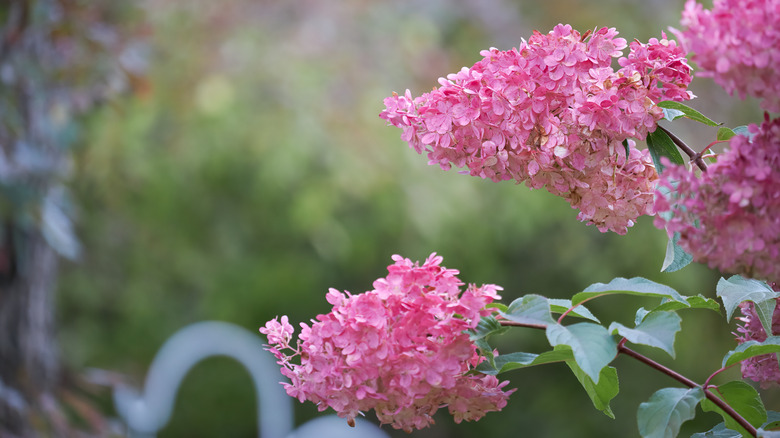3 Sweet-Sounding Varieties Of Hydrangeas Martha Stewart Stands By
We may receive a commission on purchases made from links.
Creating an outdoor area like Martha Stewart's meticulously maintained 153-acre farm might seem like a completely unachievable task for the average person, but if you're willing to work on a smaller scale, it's actually fairly simple. A standout feature of her garden is the beautiful hydrangea border (Hydrangea paniculata), which she expands routinely with new plants. On her blog, Martha shared her excitement for three charming additions this season: 'Berry White,' 'Strawberry Sundae,' and 'Vanilla Strawberry'. These gorgeous varieties of panicle hydrangeas begin blooming in mid-summer, producing flowers that start pale and grow pinker as the flowering season progresses. They also have a beautiful meaning, carrying a range of positive associations from friendship to devotion. It's no wonder hydrangeas are a favorite in wedding bouquets and flower arrangements.
While you may not have acres and acres to fill like Martha, hydrangeas can still be used as a show-stopping pop of color in your yard. Before planting, however, it's important to know how to grow and take care of your hydrangeas. A versatile plant, hydrangeas grow well in containers, as hedges, and even in mixed beds alongside companion flowers. Wherever you choose to plant them, however, make sure to avoid overcrowding your plants to ensure stunning hydrangea blooms. With proper care, you can have hydrangeas whose blooms rival those in Stewart's hedges!
How to plant your own hydrangeas
If Martha has inspired you to add some panicle hydrangeas to your garden, it's best to plant them in early fall or spring. Look for an area that's sunny in the morning and shaded in the afternoon. When planting hydrangeas in the fall, it's best to avoid encouraging too much growth before winter dormancy. Wait to fertilize your plants to prevent any blooms after planting, but be sure to give them plenty of water to help their roots take hold. Hydrangeas also prefer well-drained soil, so consider mixing some organic matter, such as Out-Grow Natural Peat Moss, into your beds if you have heavy clay soil in your garden. Then, in the spring, your hydrangeas should begin to grow in preparation for a summer of blooms.
If you choose to plant your hydrangeas in the spring, you'll want to follow different advice. Check on when the final spring frosts are expected for your area, and plant sometime after that date but before the hottest summer months. Your panicle hydrangeas should begin growing right away, but you can wait to fertilize them until they're more established. With that being said, however, you should still be providing plenty of water. Hydrangeas were named for their love of water, so they will do well in evenly-watered soil. By giving them the care they need right after planting, you'll ensure they are ready to begin blooming come summer.

